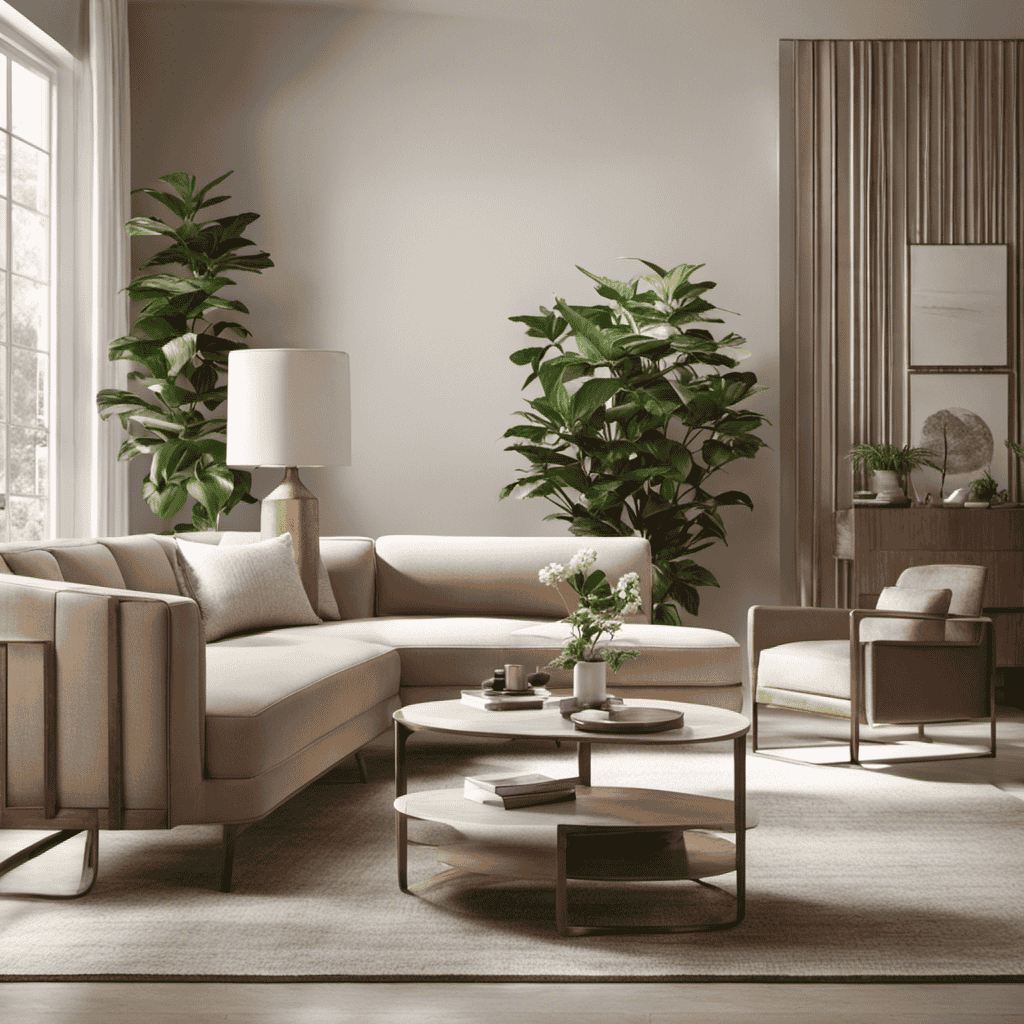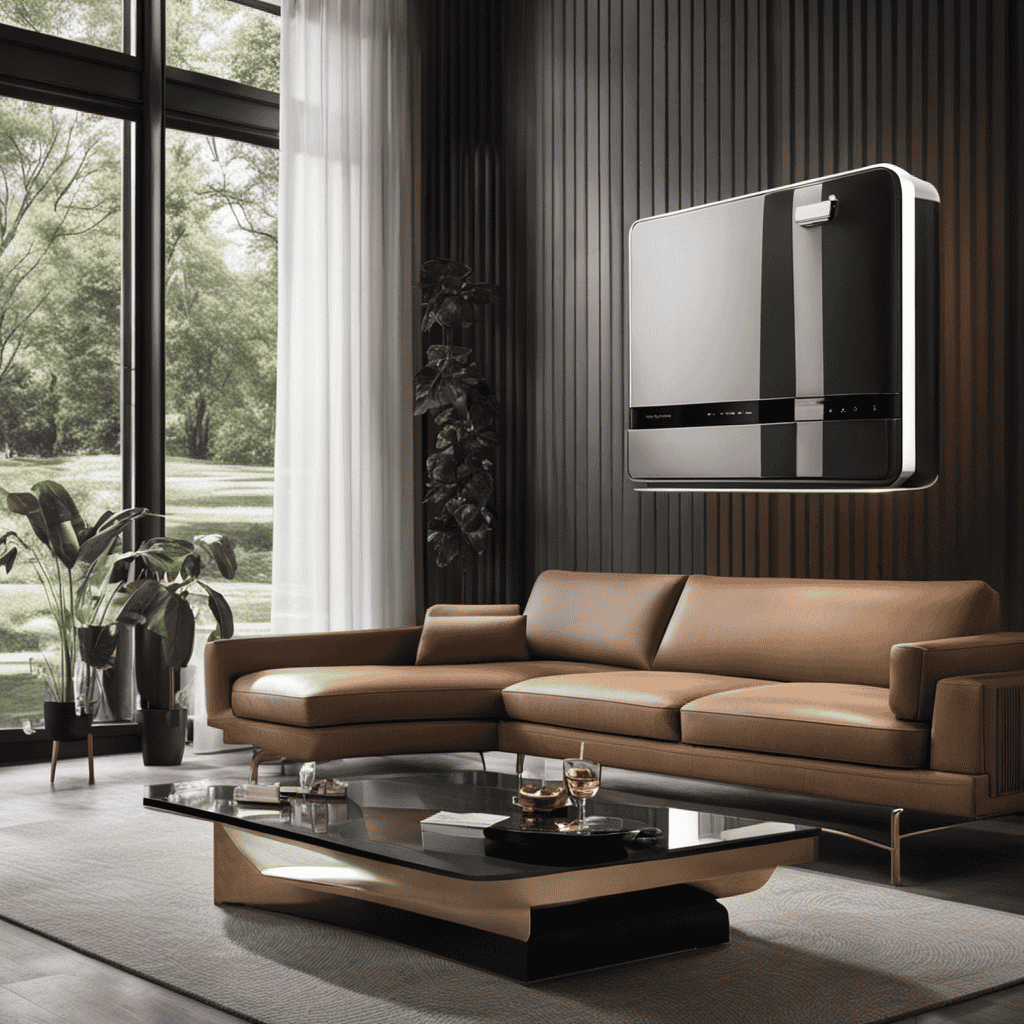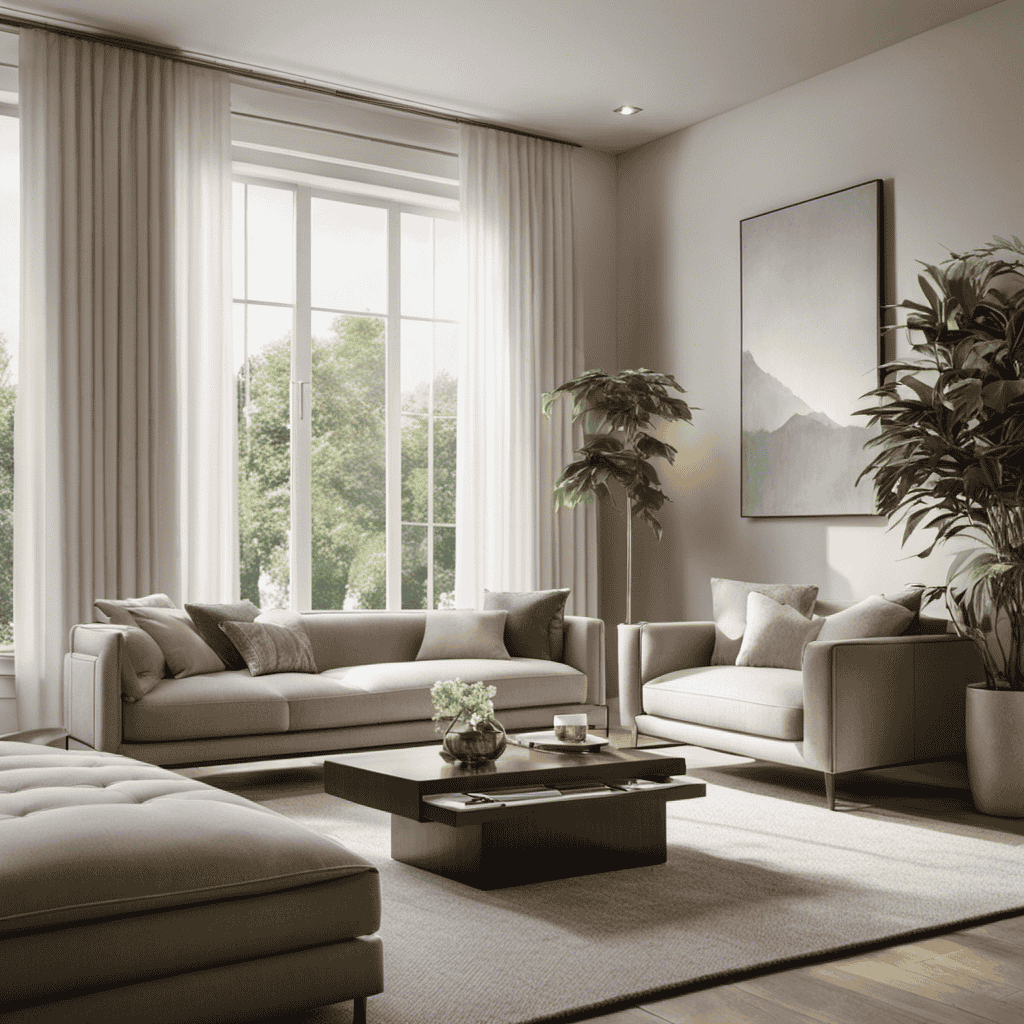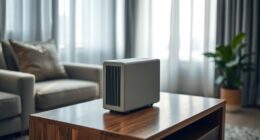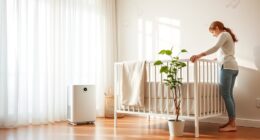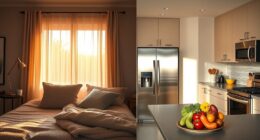So you’ve just bought the Air Purifier Hunter and you’re excited to begin experiencing cleaner, fresher air in your home.
Well, you’re in luck because I’m here to guide you through the ins and outs of using this fantastic device.
From setting it up to maximizing its efficiency, I’ll provide you with all the knowledge and tips you need to make the most out of your Air Purifier Hunter.
Get ready to breathe easy and say goodbye to airborne pollutants!
Key Takeaways
- Regularly clean and replace filters for optimal performance
- Understand and utilize the different modes for specific needs and preferences
- Place the air purifier in a central location for even distribution of purified air
- Adjust fan speed and customization options for personalized comfort and energy efficiency
Setting up the Air Purifier Hunter
Setting up the Air Purifier Hunter is a breeze with its simple instructions and user-friendly interface. When it comes to air purifier maintenance, this device makes it easy.
Regularly cleaning the filters is crucial to ensure optimal performance. The benefits of using an air purifier like the Hunter are tremendous. It helps to remove harmful airborne particles such as dust, pollen, pet dander, and even mold spores, improving indoor air quality. This is especially beneficial for those who suffer from allergies or asthma.
The Hunter Air Purifier also helps to eliminate odors, leaving your home smelling fresh and clean. With its sleek design and quiet operation, it seamlessly fits into any room.
Understanding the Different Modes of the Air Purifier Hunter
When it comes to understanding the different modes of the Air Purifier Hunter, there are a few key points to keep in mind.
First, the Mode Selection Guide provides a detailed breakdown of each mode and its specific functions, allowing users to choose the most suitable option for their needs.
Additionally, I will provide optimal mode recommendations based on factors such as room size, air quality, and specific concerns, ensuring that users can optimize their air purifier’s performance.
Mode Selection Guide
To choose the right mode for your needs, simply press the mode button on the air purifier hunter and select the desired setting. The air purifier hunter offers different modes to cater to various air purification requirements.
Here are the three modes available and their benefits:
-
Auto Mode: This mode automatically adjusts the fan speed based on the air quality in the room. It ensures efficient purification by responding to changes in air pollution levels.
-
Sleep Mode: When activated, this mode operates the air purifier at the lowest fan speed, emitting minimal noise. It is perfect for use during nighttime or when you need a quiet environment for sleeping.
-
Turbo Mode: For situations when you need immediate and intensive purification, the turbo mode is ideal. It maximizes the air purifier’s performance by running at the highest fan speed, effectively removing pollutants from the air.
Regular air purifier maintenance is crucial to ensure optimal performance and longevity. By using an air purifier, you can enjoy cleaner and fresher air, reduced allergens, and improved overall air quality.
Optimal Mode Recommendations
For the best air purification results, you should consider using the Auto Mode on your air purifier, as it adjusts the fan speed based on the room’s air quality. This mode is particularly advantageous when compared to other air purifiers on the market. The Air Purifier Hunter is designed with advanced technology that allows it to effectively detect and respond to changes in air quality. By using sensors to monitor the air, it can automatically adjust the fan speed to the appropriate level, ensuring optimal purification at all times. This not only saves energy but also ensures that the air in your room is constantly being cleaned to the highest standard. In comparison, other air purifiers may only have basic fan speed settings, lacking the ability to adapt to changing air conditions. The benefits of using the Air Purifier Hunter are clear – it provides superior air cleaning performance by continuously monitoring and adjusting its operation to maintain the best air quality possible.
Here is a table to further illustrate the advantages of the Air Purifier Hunter:
| Air Purifier Hunter | Other Air Purifiers |
|---|---|
| Auto Mode adjusts fan speed based on air quality | Basic fan speed settings |
| Advanced sensors detect changes in air quality | Lacks ability to adapt to changing conditions |
| Constantly monitors and adjusts for optimal purification | Limited effectiveness in maintaining air quality |
Adjusting the Fan Speed on the Air Purifier Hunter
You can easily adjust the fan speed on the Air Purifier Hunter. This feature allows you to customize the airflow based on your specific needs and preferences. Here are three reasons why this is beneficial:
-
Personalized Comfort: By adjusting the fan speed, you can create a comfortable environment in your home or office. Whether you prefer a gentle breeze or a more powerful airflow, the Air Purifier Hunter gives you the freedom to choose.
-
Energy Efficiency: Unlike other air purifiers that have fixed fan speeds, the Air Purifier Hunter allows you to optimize the energy consumption. You can lower the fan speed when the air quality is good, saving energy and reducing your carbon footprint.
-
Noise Control: Some air purifiers can be quite noisy, especially when running at maximum speed. The Air Purifier Hunter offers various fan speed options, including a quiet mode, ensuring that you can enjoy clean air without disturbing your peace and quiet.
Maximizing the Air Purification Efficiency of the Air Purifier Hunter
Now that you know how to adjust the fan speed on your Air Purifier Hunter, it’s important to understand how to maximize its air purification efficiency.
Proper air purifier maintenance is key to improving air quality in your home. Regularly cleaning and replacing the filters is vital to ensure the unit functions optimally. Check the user manual for instructions on how often to clean or replace the filters based on the manufacturer’s recommendations.
Additionally, keeping the surrounding area clean and free from dust and debris will help the air purifier work more efficiently. It’s also a good idea to place the unit in a central location to ensure the air is evenly purified throughout the room.
Following these maintenance tips will help you get the most out of your Air Purifier Hunter and enjoy clean, fresh air in your home.
Maintaining and Cleaning the Air Purifier Hunter
To maintain and clean your Air Purifier Hunter, start by unplugging the unit and removing the filters for cleaning or replacement. Regular maintenance is essential to ensure optimal performance and prolong the lifespan of your air purifier.
Here are three important steps to follow when maintaining and cleaning your Air Purifier Hunter:
-
Clean the pre-filter: This filter is responsible for capturing larger particles like dust and hair. Remove the pre-filter and gently vacuum or rinse it with water. Allow it to dry completely before reinstalling.
-
Replace the HEPA filter: The HEPA filter is responsible for removing smaller particles like pollen and pet dander. Check the manufacturer’s instructions for the recommended replacement schedule. When replacing the filter, make sure to align it properly and securely.
-
Clean the exterior: Wipe the exterior of the air purifier with a soft, damp cloth to remove any dust or dirt. Avoid using harsh chemicals or abrasive cleaners that may damage the unit.
Troubleshooting Common Issues With the Air Purifier Hunter
When it comes to the Air Purifier Hunter, there are a couple of common issues that users may encounter.
One of these is the need for filter replacement and the frequency at which it should be done.
Another issue that may arise is the emission of strange odors from the purifier.
In this discussion, I will provide detailed information on the recommended filter replacement frequency and possible causes of strange odor emission, along with troubleshooting solutions.
Filter Replacement Frequency
The filter replacement frequency for the Hunter air purifier depends on the usage and air quality. Regular maintenance of the air purifier is crucial to ensure its optimum performance and to enjoy the benefits of clean air. Here are three key points to keep in mind regarding filter replacement:
-
Usage: The more frequently you use the air purifier, the faster the filters will get clogged with pollutants. If you use it consistently in a high-traffic area or during peak pollution seasons, you may need to replace the filters more frequently.
-
Air Quality: The level of air pollution in your area can also impact the filter replacement frequency. If you live in a highly polluted city or near industrial areas, the filters may need to be replaced more often to maintain effective air purification.
-
Filter Lifespan: Each Hunter air purifier model comes with specific filter lifespan recommendations. It is important to follow these guidelines to ensure that the filters are replaced at the right time for optimal air purification.
Regular filter replacement is essential for maintaining the efficiency of your Hunter air purifier and enjoying the benefits of clean and fresh air in your home. Now, let’s move on to the next section where we will discuss the issue of strange odor emission.
Strange Odor Emission
If you notice a strange odor coming from your air purifier, it may be a sign that the filters need to be replaced. When the filters become dirty or clogged, they can emit unpleasant smells instead of effectively removing them.
To deal with stubborn odors, there are a few tips you can follow. First, check the manufacturer’s instructions on how often to replace the filters. Regularly replacing them will ensure optimal performance and eliminate any lingering smells.
Additionally, consider using air purifiers with activated carbon filters, as they are specifically designed to target and remove odors from the air.
Lastly, keep the air purifier in a well-ventilated area and avoid placing it near sources of strong odors, such as cooking or smoking areas.
Frequently Asked Questions
Can the Air Purifier Hunter Remove Allergens and Pet Dander From the Air?
Yes, the Air Purifier Hunter is effective in removing allergens and pet dander from the air. To maintain optimal performance, clean the filters regularly and follow the manufacturer’s instructions for cleaning and maintenance.
How Often Should the Filters Be Replaced in the Air Purifier Hunter?
When should you replace the filters in the air purifier hunter? To properly maintain the air purifier hunter, it is recommended to replace the filters every 6-12 months, depending on usage and air quality.
Does the Air Purifier Hunter Have a Timer Function?
Yes, the Air Purifier Hunter does have a timer function. To set the timer, go to the settings menu and select the timer option. From there, you can choose the desired time duration for the purifier to run.
Can the Air Purifier Hunter Be Used in Large Rooms or Open Spaces?
Yes, the Air Purifier Hunter can be used in large rooms or open spaces. It is suitable for both small rooms and confined spaces. Additionally, it effectively removes smoke and odors from the air.
Is the Air Purifier Hunter Noisy When Running on Its Highest Fan Speed?
No, the Air Purifier Hunter is not noisy when running on its highest fan speed. It is designed to operate quietly, ensuring a peaceful environment. Additionally, it is energy-efficient, minimizing energy consumption while maintaining optimal performance.
How Can I Use an Air Purifier for Different Purposes, Such as an Nsa Console Air Purifier for Hunter?
The uses for NSA air purifier are versatile. For instance, the Hunter model can be used to remove allergens, smoke, and pet dander from the air. It can also eliminate odors and airborne bacteria, making the air fresher and healthier for any indoor space.
Conclusion
In conclusion, using the Air Purifier Hunter is a breeze once you have set it up and understood its different modes and fan speed settings.
By maximizing its air purification efficiency, you can ensure a cleaner and healthier environment for you and your family.
Regular maintenance and cleaning will also help prolong the lifespan of the device.
So, why settle for polluted air when you can easily improve the quality of the air you breathe with the Air Purifier Hunter?
